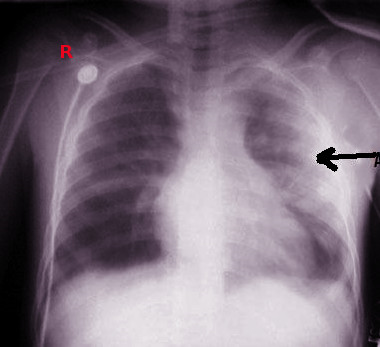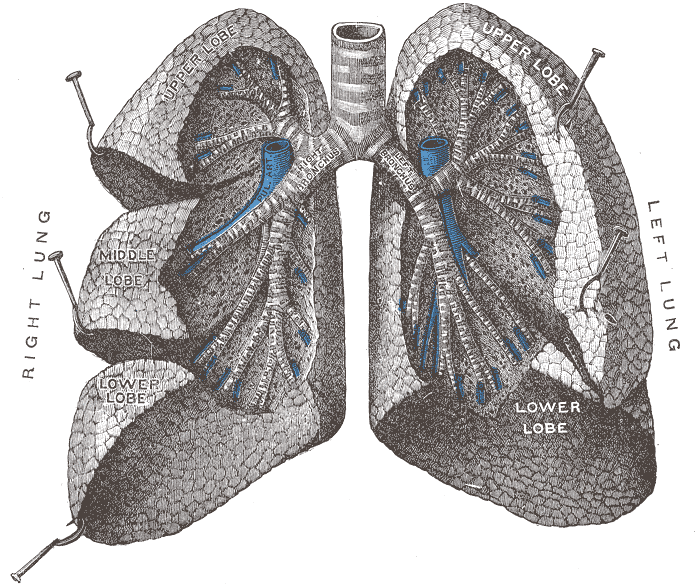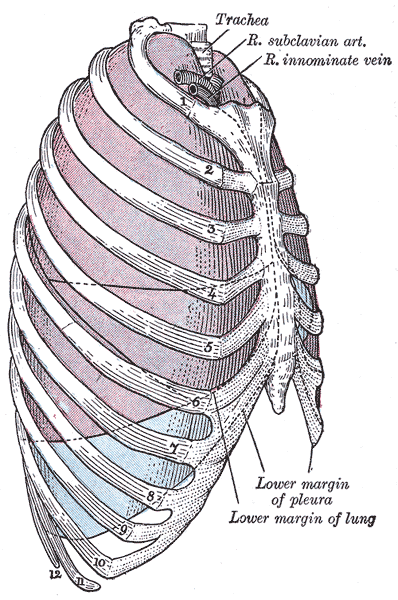[2]
Cohn SM. Pulmonary contusion: review of the clinical entity. The Journal of trauma. 1997 May:42(5):973-9
[PubMed PMID: 9191684]
[3]
Rendeki S, Molnár TF. Pulmonary contusion. Journal of thoracic disease. 2019 Feb:11(Suppl 2):S141-S151. doi: 10.21037/jtd.2018.11.53. Epub
[PubMed PMID: 30906578]
[4]
Ullman EA, Donley LP, Brady WJ. Pulmonary trauma emergency department evaluation and management. Emergency medicine clinics of North America. 2003 May:21(2):291-313
[PubMed PMID: 12793615]
[5]
Patel S, Yelne P, Gaidhane SA, Kumar S, Acharya S, Shah D, Patel M, Kakde Y. Lightning Strike Presenting as Fatal Lung Contusion: A Case Report. Cureus. 2022 Dec:14(12):e33125. doi: 10.7759/cureus.33125. Epub 2022 Dec 30
[PubMed PMID: 36726903]
Level 3 (low-level) evidence
[6]
Ekpe EE, Eyo C. Determinants of mortality in chest trauma patients. Nigerian journal of surgery : official publication of the Nigerian Surgical Research Society. 2014 Jan:20(1):30-4. doi: 10.4103/1117-6806.127107. Epub
[PubMed PMID: 24665200]
[7]
Ziegler DW, Agarwal NN. The morbidity and mortality of rib fractures. The Journal of trauma. 1994 Dec:37(6):975-9
[PubMed PMID: 7996614]
[8]
Ganie FA, Lone H, Lone GN, Wani ML, Singh S, Dar AM, Wani NU, Wani SN, Nazeer NU. Lung Contusion: A Clinico-Pathological Entity with Unpredictable Clinical Course. Bulletin of emergency and trauma. 2013 Jan:1(1):7-16
[PubMed PMID: 27162815]
[9]
Deng H, Tang TX, Yao Y, Zhang C, Wu H, Li ZW, Tang LS, Chen D, Chang TD, Yang JZ, Luo JL, Dong L, Yang XP, Tang ZH. The incidence, clinical characteristics, and outcome of polytrauma patients with the combination of pulmonary contusion, flail chest and upper thoracic spinal injury. Injury. 2022 Mar:53(3):1073-1080. doi: 10.1016/j.injury.2021.09.053. Epub 2021 Oct 1
[PubMed PMID: 34625240]
[10]
van Wessem KJP, Niemeyer MJS, Leenen LPH. Polytrauma patients with severe cervical spine injuries are different than with severe TBI despite similar AIS scores. Scientific reports. 2022 Dec 13:12(1):21538. doi: 10.1038/s41598-022-25809-8. Epub 2022 Dec 13
[PubMed PMID: 36513675]
[11]
Sutyak JP, Wohltmann CD, Larson J. Pulmonary contusions and critical care management in thoracic trauma. Thoracic surgery clinics. 2007 Feb:17(1):11-23, v
[PubMed PMID: 17650693]
[12]
Benhamed A, Ndiaye A, Emond M, Lieutaud T, Boucher V, Gossiome A, Laumon B, Gadegbeku B, Tazarourte K. Road traffic accident-related thoracic trauma: Epidemiology, injury pattern, outcome, and impact on mortality-A multicenter observational study. PloS one. 2022:17(5):e0268202. doi: 10.1371/journal.pone.0268202. Epub 2022 May 6
[PubMed PMID: 35522686]
Level 2 (mid-level) evidence
[13]
Doyle JE, Diaz-Gutierrez I. Traumatic sternal fractures: a narrative review. Mediastinum (Hong Kong, China). 2021:5():34. doi: 10.21037/med-21-27. Epub 2021 Dec 25
[PubMed PMID: 35118339]
Level 3 (low-level) evidence
[14]
Oppenheimer L, Craven KD, Forkert L, Wood LD. Pathophysiology of pulmonary contusion in dogs. Journal of applied physiology: respiratory, environmental and exercise physiology. 1979 Oct:47(4):718-28
[PubMed PMID: 389910]
[15]
Prentice D, Ahrens T. Pulmonary complications of trauma. Critical care nursing quarterly. 1994 Aug:17(2):24-33
[PubMed PMID: 8055358]
[17]
Ward PA. Acute lung injury: how the lung inflammatory response works. The European respiratory journal. Supplement. 2003 Sep:44():22s-23s
[PubMed PMID: 14582896]
[18]
Raghavendran K, Davidson BA, Huebschmann JC, Helinski JD, Hutson AD, Dayton MT, Notter RH, Knight PR. Superimposed gastric aspiration increases the severity of inflammation and permeability injury in a rat model of lung contusion. The Journal of surgical research. 2009 Aug:155(2):273-82. doi: 10.1016/j.jss.2008.08.020. Epub 2008 Sep 16
[PubMed PMID: 19515386]
[19]
Allen GS, Cox CS Jr. Pulmonary contusion in children: diagnosis and management. Southern medical journal. 1998 Dec:91(12):1099-106
[PubMed PMID: 9853720]
[20]
Moseley RV, Vernick JJ, Doty DB. Response to blunt chest injury: a new experimental model. The Journal of trauma. 1970 Aug:10(8):673-83
[PubMed PMID: 5451078]
[21]
Garzon AA, Seltzer B, Karlson KE. Physiopathology of crushed chest injuries. Annals of surgery. 1968 Jul:168(1):128-36
[PubMed PMID: 5673189]
[22]
Allen GS, Coates NE. Pulmonary contusion: a collective review. The American surgeon. 1996 Nov:62(11):895-900
[PubMed PMID: 8895709]
[23]
Miller LA. Chest wall, lung, and pleural space trauma. Radiologic clinics of North America. 2006 Mar:44(2):213-24, viii
[PubMed PMID: 16500204]
[24]
Kaewlai R, Chatpuwaphat J, Butnian K, Thusneyapan K, Panrong N, Lertpipopmetha W, Wongpongsalee T. Thoracic Inlet in Cervical Spine CT of Blunt Trauma Patients: Prevalence of Pathologies and Importance of CT Interpretation. Tomography (Ann Arbor, Mich.). 2022 Nov 19:8(6):2772-2783. doi: 10.3390/tomography8060231. Epub 2022 Nov 19
[PubMed PMID: 36412690]
[25]
Schild HH, Strunk H, Weber W, Stoerkel S, Doll G, Hein K, Weitz M. Pulmonary contusion: CT vs plain radiograms. Journal of computer assisted tomography. 1989 May-Jun:13(3):417-20
[PubMed PMID: 2723172]
[26]
Miller PR, Croce MA, Bee TK, Qaisi WG, Smith CP, Collins GL, Fabian TC. ARDS after pulmonary contusion: accurate measurement of contusion volume identifies high-risk patients. The Journal of trauma. 2001 Aug:51(2):223-8; discussion 229-30
[PubMed PMID: 11493778]
[28]
Planquart F, Marcaggi E, Blondonnet R, Clovet O, Bobbia X, Boussat B, Pottecher J, Gauss T, Zieleskiewicz L, Bouzat P. Appropriateness of Initial Course of Action in the Management of Blunt Trauma Based on a Diagnostic Workup Including an Extended Ultrasonography Scan. JAMA network open. 2022 Dec 1:5(12):e2245432. doi: 10.1001/jamanetworkopen.2022.45432. Epub 2022 Dec 1
[PubMed PMID: 36477480]
[29]
Frishman WH, Alpert JS. Commotio Cordis and the Triumph of Out-of-Hospital Cardiopulmonary Resuscitation. The American journal of medicine. 2023 May:136(5):401-402. doi: 10.1016/j.amjmed.2023.01.007. Epub 2023 Jan 31
[PubMed PMID: 36736646]
[30]
Thomas KP, Sainudeen S, Jose S, Nadhari MY, Macaire PB. Ultrasound-Guided Parasternal Block Allows Optimal Pain Relief and Ventilation Improvement After a Sternal Fracture. Pain and therapy. 2016 Jun:5(1):115-22. doi: 10.1007/s40122-016-0050-5. Epub 2016 Mar 21
[PubMed PMID: 27001634]
[31]
Reitano E, Gavelli F, Iannantuoni G, Fattori S, Airoldi C, Matranga S, Cioffi SPB, Ingala S, Virdis F, Rizzo M, Marcomini N, Motta A, Spota A, Maestrone M, Ragozzino R, Altomare M, Castello LM, Della Corte F, Vaschetto R, Avanzi GC, Chiara O, Cimbanassi S. In-Hospital Predictors of Need for Ventilatory Support and Mortality in Chest Trauma: A Multicenter Retrospective Study. Journal of clinical medicine. 2023 Jan 16:12(2):. doi: 10.3390/jcm12020714. Epub 2023 Jan 16
[PubMed PMID: 36675639]
Level 2 (mid-level) evidence
[34]
Van Wijck SFM, Pieracci FM, Smith EF, Madden K, Moore EE, Wijffels MME, Werner NL. Rib fixation in patients with severe rib fractures and pulmonary contusions: Is it safe? The journal of trauma and acute care surgery. 2022 Dec 1:93(6):721-726. doi: 10.1097/TA.0000000000003790. Epub 2022 Sep 19
[PubMed PMID: 36121283]
[35]
Dagod G, Ramin S, Solovei L, Capdevila X, Charbit J. A combined management with vv-ECMO and independent lung ventilation for asymmetric chest trauma. General thoracic and cardiovascular surgery. 2021 May:69(5):902-905. doi: 10.1007/s11748-021-01587-4. Epub 2021 Jan 13
[PubMed PMID: 33439375]
[36]
Nikischin W, Gerhardt T, Everett R, Bancalari E. A new method to analyze lung compliance when pressure-volume relationship is nonlinear. American journal of respiratory and critical care medicine. 1998 Oct:158(4):1052-60
[PubMed PMID: 9769260]



